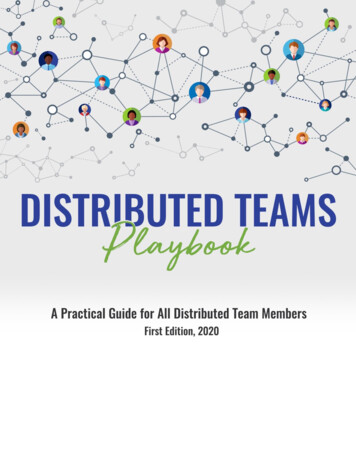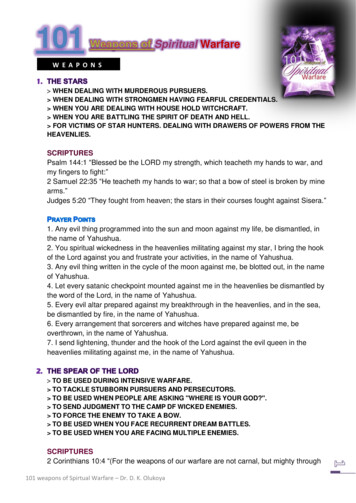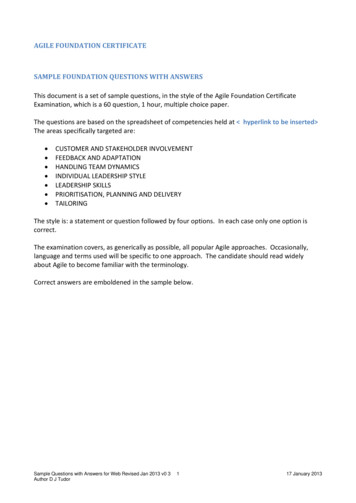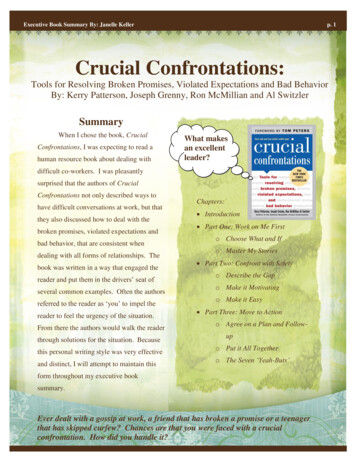
Transcription
Dealing with Difficult TeamMembersBringing Out the Best of Those atTheir Worst
Sue DeLaune, MN, RN, CNECo-Founder & PartnerDIREC Learning, LLCsuejaydel@att.net
Learning OutcomeDevelop strategies for coping effectively withpeople exhibiting difficult behaviors.3
Who Are Our “Difficult”? PatientsFamiliesPhysiciansSupervisors Co-workersSpouses/PartnersChildren Adolescents In-lawsOthers?4
Identifying Your “Difficult” List 3 “difficult” people in your lifeWhat makes each person so difficult to you?What is your usual response to that person?What do you want from your interaction withthat person? SOPsPaper exercise5
The 10 Most (Un)Wanted List SteamrollerGrenadeSniperWet BlanketYes Person Maybe-personClamKnow-it-allThink-they-knowit all Whiner6
Motivation of Difficult People Low self-esteem Need for control Attention-seeking7
The Steamroller tuousAlways “right”8
Steamroller: DynamicsInsecurity anger others’defensive reinforcesinsecurity9
Steamroller: Dynamics (cont.) False sense of superiority bydemeaning others Knows what others should do impatience10
Responding to Steamrollers Stand up for self Give time to run down Don’t worry about being polite Get his attention Sit down11
Steamroller: Responding To Use “I” languageMaintain eye contactAvoid a head-on fightFocus on issue .not personality12
The Grenade: DescriptionVerbally explosiveRant & raveTemper tantrums13
Grenade: Dynamics Immediate need for gratification Feeling of unimportance14
Grenade prevention Identify the trigger(s). Eliminate or reduce its intensity15
Working with Grenades:GOALTAKE CONTROL OFTHE SITUATIONWHEN THEGRENADE STARTSTO LOSE IT16
Grenade: Response Strategies(1) Get their attention(2) Aim for the heart(3) Reduce the intensity17
Responding to Grenades 1st tendency Retaliate or withdrawForgive temporary insanityStop blamingUnsent letterChange perspective18
WHAT TO DO WHEN SOMEONE STARTSYELLING Keep focused on solutions Ask them to leave Say their name19
Sniper: Description Maintain protective cover Hide, take “pot shots” Weapons: innuendos, non-playfulteasing, non-subtle digs Attack is covered by “nice”nonverbals20
Sniper: Dynamics Passive form of aggression indirectStrong belief of what others SHOULD doNeed to controlHate to loseVERY adept21
Responding to Snipers Surface the attack (poke holes insmokescreen) Confrontation Peer confirmation Provide an alternative Focus on problem-solving22
Wet Blanket: Description Negativity others’ ideas,suggestions State negativity with great conviction Devastating to work group’s efficacy23
The Wet Blanket: Dynamics Build on natural tendency to negativityBelieve things are out of their controlThink they have no influence over livesHelplessness, powerlessness24
Responding to a Wet Blanket Avoid getting drawn into negativityRealistic optimismDo not argueAvoid proposing solutions25
Responding to a Wet Blanket (cont.) Identify worst-case scenario Be prepared to go solo Use anger constructively26
Handling Complaints Use names and titles of other personnel.Give directions tactfullyDon’t say this is a common complaint.Show that corrective action has begun.27
Complaints (cont.) Research and report on progress. Express concern w/o automaticallyacknowledging fault/promising toomuch. End the interaction on a positive note28
Working with Negativists Getting readyOpen-ended ?sReflectingEchoingSilence -- supportive, respectful29
Working with Negativists Use empathy Paraphrase Take notes:(1) to get details(2) to convey interest30
The Yes Person:Description Super-agreeable Makes promises that are rarely kept Eagerly volunteers for impossibleworkload needs help to focus on realistic Gives appearance of progress Fail to deliver Blames others31
Yes-Person: Dynamics Seeks approval Procrastination1) Perfectionism2) Fear of failure3) Fear of success32
The Yes Person: Do Reject unrealistic promisesExplicit delegationHave them id. potential obstaclesConfront immediatelyPraise33
Yes-Person: Don’ts Accept unrealistic commitmentsGive opportunity to volunteerExpect them to change without helpShunt work around34
The ClamShy, quietSilent, nonresponsiveOthers never knowclam’s thoughtsExtremely passive“Fine, just fine!” Withdraw whenthreatened Feel no one cares Fears rejection Major needs(1) get along w/others (2) do thingsright35
Responding to Clams Slow yourself down (not look aggressive) Maintain emotional control LOOK AS IF YOU HAVE ALL THE TIME IN THEWORLD Appear relaxed and calm Take time to compose self Demonstrate empathy Follow nonverbal leads36
GoalPERSUADE THE CLAM TO TALK37
Action Plan: Clam Plan enough time (involves planning ahead) Ask open-ended questions expectantlyWho -- What -- Where -- When -- How Use the silent, expectant stare. Guess. Lighten it up ---- Use caution Remind that you intend to have a dialogue,not a monologue. Show the future38
The Know-It-All39
The Know-It-All DescriptionSeldom doubts selfLow tolerance for correction or contradictionKnowledgeable & competentHighly outspoken40
The Know-It-All: Dynamics Need for controlBeing wrong humiliationSense of entitlementInsecurity based on need to:(1)be “right”(2) be accepted41
GOAL: Know-It-AllOPEN HIS/HER MIND TO NEWINFORMATION AND IDEAS.42
Responding to Know-It-All Resist becoming a “Know-It-All”Avoid resentment @ his non-listeningFlexible approachReview your previous experiences with otherKnow-It-Alls Reframe the experience43
Responding to Know-It-All (cont.) Be prepared and know your stuff. Present your views indirectly.--- avoidchallenging Use “we” “us” “our” Turn them into mentors Demonstrate your competence in a nonthreatening way Decide whether it’s worth the effort!44
The Think-They-Know-It-All:Description Abrasive, pushyLearn just enough to sound educatedAct as if they know what they’re talking reAddicted to exaggerationAttention-seeking behavior45
The Think-They-Know-It-All: Dynamics Need to be appreciated Believe in themselves --- do NOT see self asuntruthful More defensive more repetitious Others eventually stop listening Increases isolation Their good ideas get dismissed w/ distortions46
The Think-They-Know-It-All: Responses Avoid challengingDo not stretch the truth in other directionRestrain urge to show ‘em upPut the behavior in perspectiveDemonstrate compassion -- Offer a face-savingdevice Exhibit patience47
The Think-They-Know-It-All: ActionPlan Give some attention Acknowledge their intent, not content48
You need to decide whetheryou need (or are willing) to dowhat it takes to deal effectivelywith the person you can’tstand.
Action Plan for Coping Description of difficult behavior What has NOT worked before What will you do? When?50
ACTIONS MOST PEOPLE SEE ASSUPPORTIVE Repeat what you’ve heard Put both facts and feelings into astatement about what has been said Use empathy Ask the other person what, if anything,they want from you51
Managing Conflict:Basic ApproachACTIVE Listening52
Active Listening Getting readyOpen-ended ?sReflectingEchoingSilence --supportive,respectful Empathy Paraphrase53
Responding to Anger STOP whatever you are doingLOOK directly at the angry personLISTEN for feelings & sourcesRESPONDAcknowledge & accept– Ask about SPECIFIC cause(s)– Admit errors - no excessive apologies– Focus on problem-solving54
WHEN DEALING WITH AN ANGRYPERSON, AVOID Punishing the personAppealing to logicDenying the person’s logicAttacking or retaliating55
TALKING BACK WITHOUT RAISINGYOUR VOICE Verbalize the problemStay calmUse “I” statementsStick to the factsSay it again (“Broken record”)56
STRATEGIES FOR DEALING WITH DIFFICULTBEHAVIORStrategy #1: ASSESS THE SITUATION: Chronic or situational? Is reaction out of proportion to situation? Triggering event57
Strategy #2: Evaluate the Dynamics Determine defensive responses Self-blameBlame othersDig inDistractvs.vs.vs.vs.Give inFightWithdrawMake noise58
Strategy #3: LET GO OF MAGICALTHINKING Stop wishing the “difficult” person weredifferent Circle of influence Give it up!59
#4: THINK FROM AN OBJECTIVEPERSPECTIVE Get some distance between you and thedifficult behavior Label the behavior Empathy Humorous imagery60
Strategy #5Identify source(s) of YOUR feelings61
#6: Develop action plan Change your dance step Choice is power62
#7: Implement the plan TimingPreparationRehearsalPractice63
#8: MONITOR EFFECTIVENESS OF YOURAPPROACH Know when to abandon the coping effort Enough already!!64
#9: UNCOVER THE TREASURE“In every problem there is a gift.” (R Bach)Identify the lesson(s)65
References/Recommended Readings Bell, A., & Smith, A. Winning with difficultpeople. Barrons. Berstein, A. 2012. Emotional vampires:Dealing with people who drain you dry (2nd EdRev). McGraw Hill. Bramson, R. 1988. Coping with difficultpeople in business and in life. RandomHouse.66
Brinkman, R. & Kirschner, R. 2012. Dealingwith people you can’t stand. McGraw-Hill Bloch, J. P. 2013. Handling difficult people.Adams Media. Cotton, D. 2014. Managing difficult people in aweek. Quercus. Hall, S. 2015. How to manage difficult peoplewith ease --- are you assertive or a wimp?unique5stardeals.67
Carter, J. 2003/ Nasty people: how to stopbeing hurt by them without becoming one ofthem (2nd ed.). McGraw Hill. Kerpen, D. 2016. The art of people: 11 simplepeople skills that will get you everything youwant. Crown. Lerner, H. (2014). The dance of anger(Reprint). HarperCollins.68
Shepard, G. 2005. How to manage problememployees: A step-by-step guide for turningproblem employees into high performers.Wiley. Thompson, J. 2013. Verbal judo: The gentle artof persuasion. Harper Collins. Willett, A. 2016. Leading the unleadable: Howto manage mavericks, cynics, divas, and otherdifficult people. AMACOM.69
people. Barrons. Berstein, A. 2012. Emotional vampires: Dealing with people who drain you dry (2nd Ed Rev). McGraw Hill. Bramson, R. 1988. Coping with difficult










